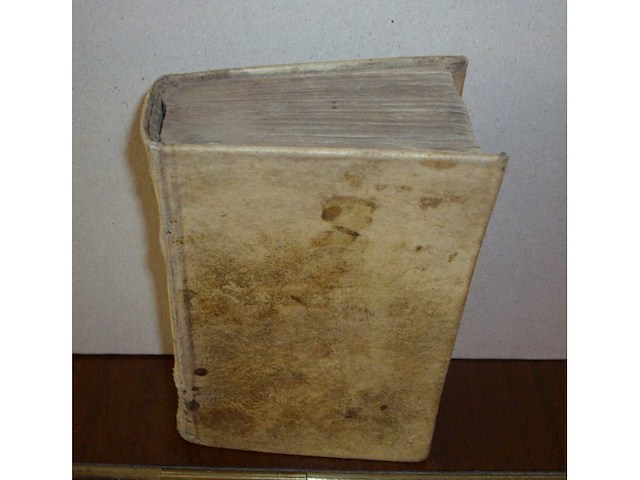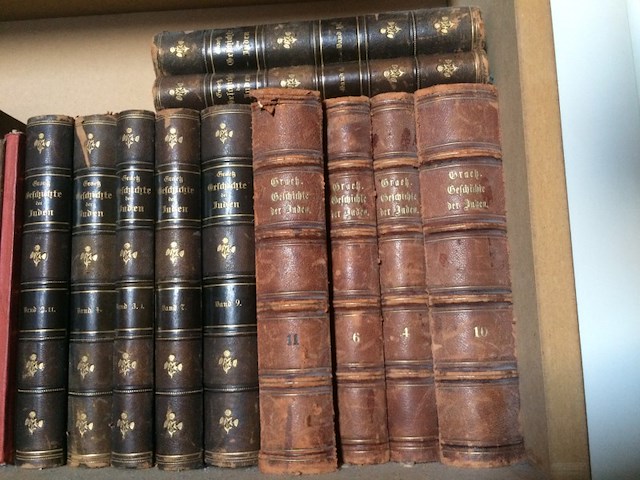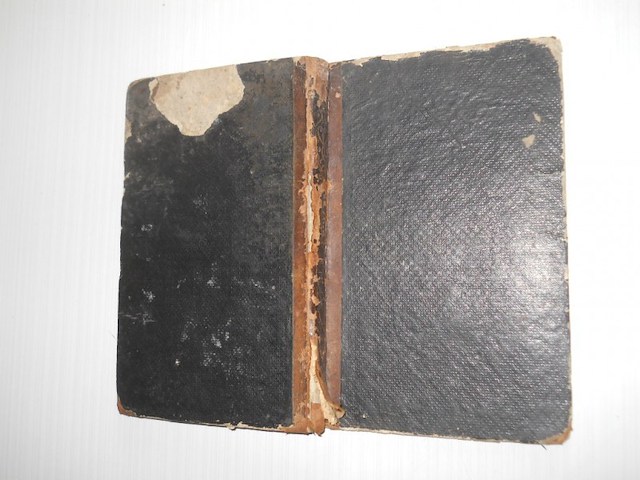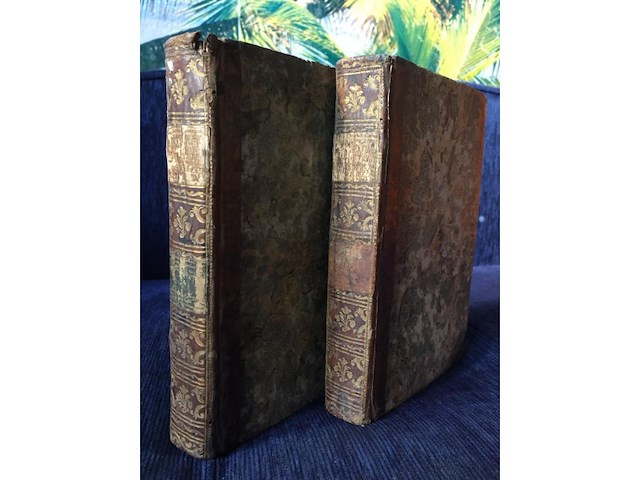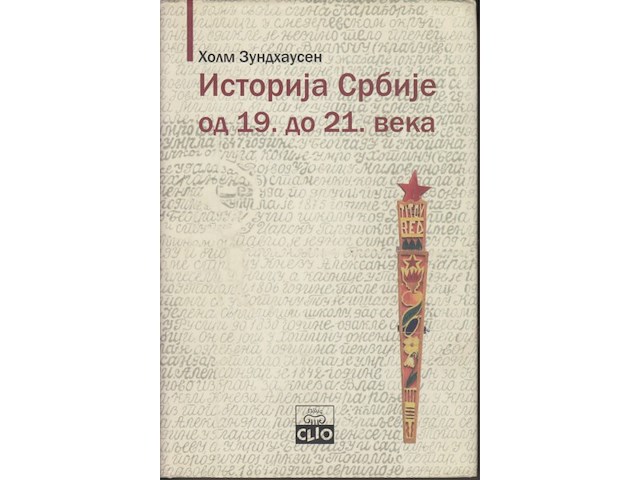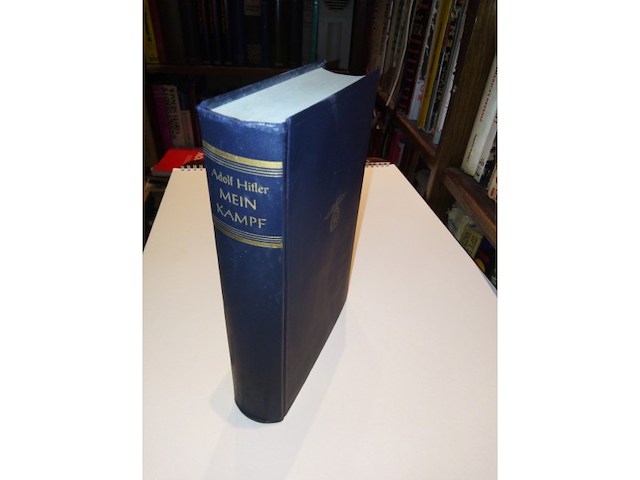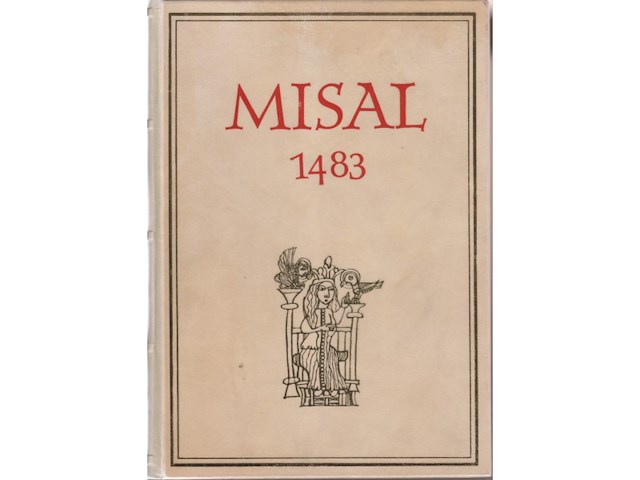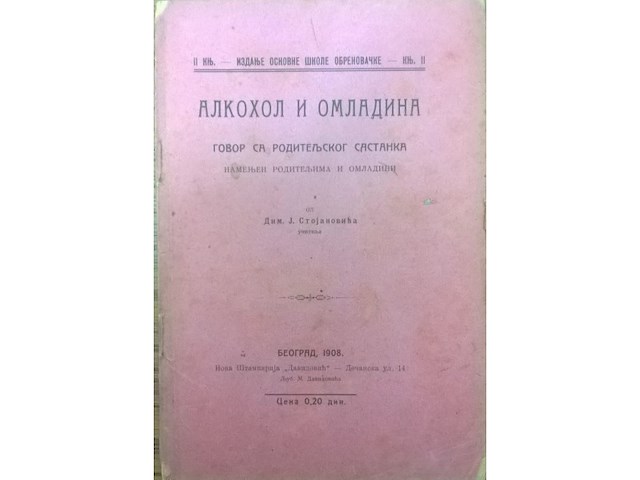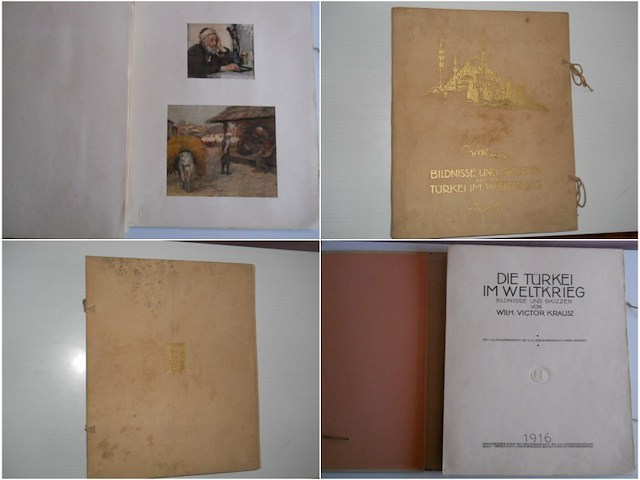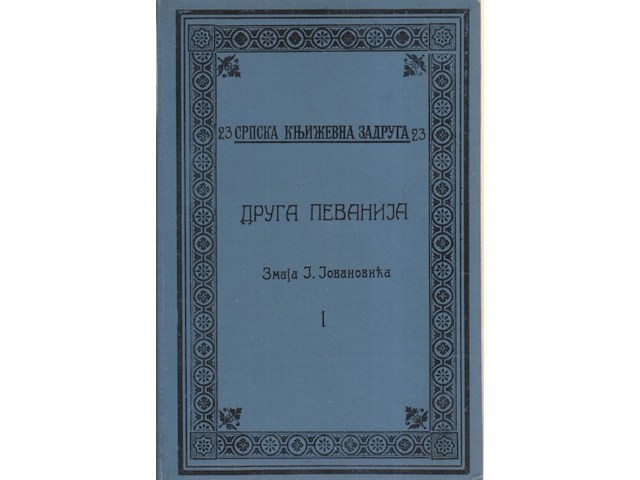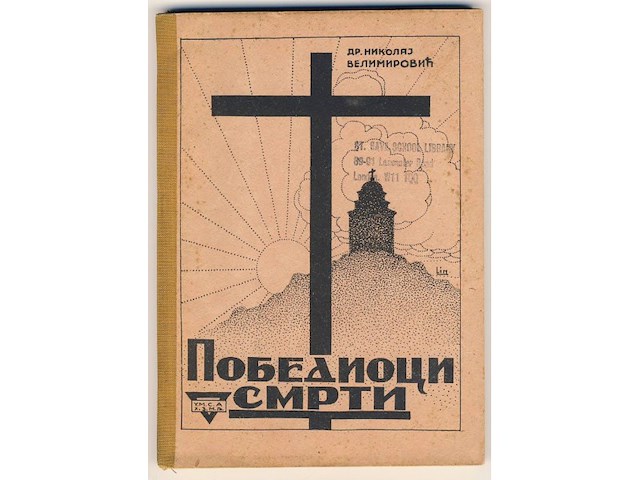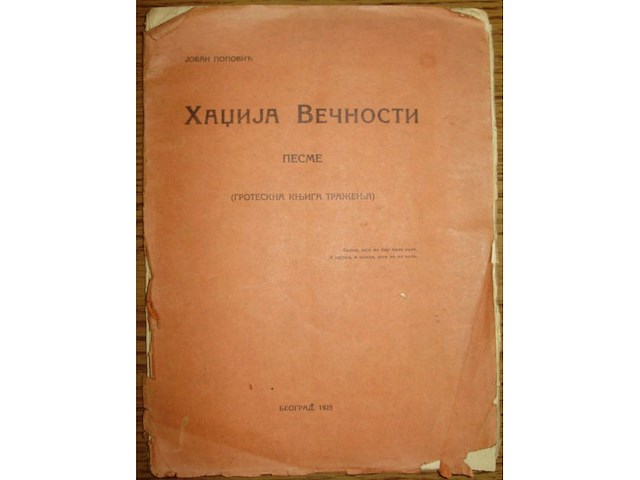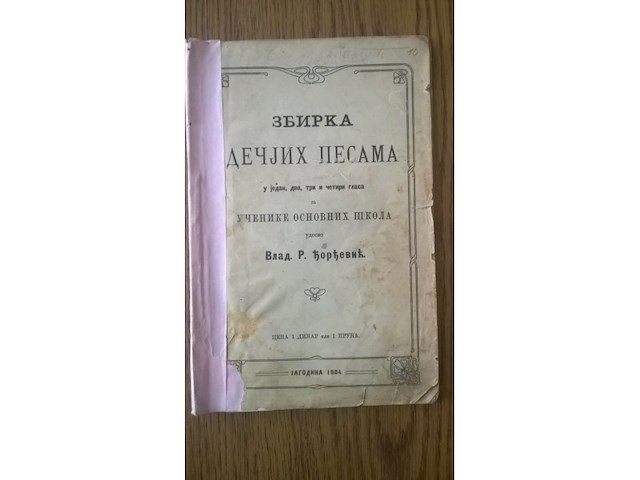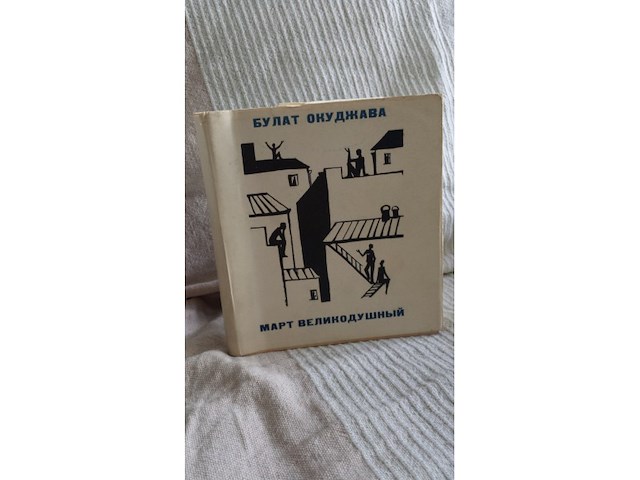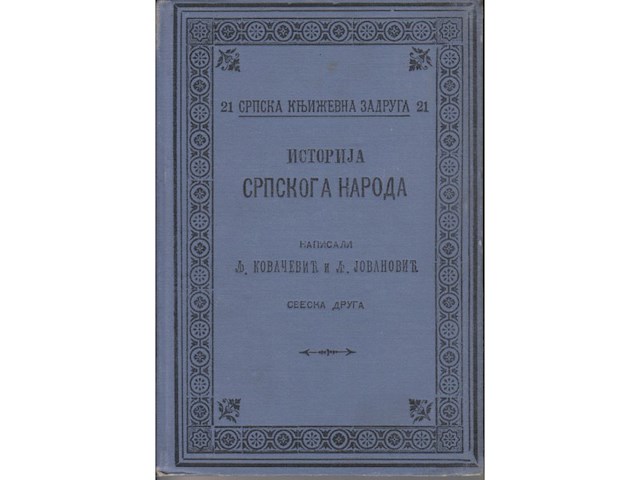Pratite promene cene putem maila
- Da bi dobijali obaveštenja o promeni cene potrebno je da kliknete Prati oglas dugme koje se nalazi na dnu svakog oglasa i unesete Vašu mail adresu.
26-50 od 19322 rezultata
Režim promene aktivan!
Upravo ste u režimu promene sačuvane pretrage za frazu .
Možete da promenite frazu ili filtere i sačuvate trenutno stanje
Aktivni filteri
Nvclevs Catecheticvs : Continens Brevi Compendio Totam Doctrinam Fidei Ac Morvm E Diversis Avthoribvs Ervtvs (Nucleus Catecheticus: Continens Brevi Compendio Totam Doctrinam Fidei Ac Morum E Diversis Authoribus Erutus), Sacrae Scripturae locis, SS. Patrum Authoritatibus, nec non selectionibus Historiis illustratus Autor: Mercator, Bernardinus Mesto štampe: Coloniae Agrippinae (Keln) Godina izdanja: 1663. Izdavač: (Johann) Wilhelm Friesse Jezik: latinski Broj stranica: 327 numerisanih Predgovor: Georgio ab Eyschen (Georges Eyschen, Georg von Eyschen) PRVO IZDANJE FIRST EDITION Prvo i veoma retko izdanje koje smo zasad našli samo u Bayerische Staatsbibliothek u Minhenu. Format 32mo (90 x 140 mm), kartonske korice (originalne), stanje izuzetno. Na prednjoj korici i prva tri lista nekoliko rupica širine do 2 mm (ne narušavaju tekst). Na unutrašnjoj strani prednje korice otrt natpis mastilom. Na poslednja dva lista (neštampana) nalazi se zapis rukom, na latinskom. Knjiga ima sve stranice i sve su u originalnom povezu, osim naslovne stranice, koja je potkraćena i heftalicom pričvršćena, tako da na njoj nedostaje donji deo naslova i godina izdanja. Godina izdanja (1663) rukom je dopisana u gornjem, sačuvanom delu tog lista, a poređenjem sloga i oštećenja kod štamparskih odlivaka (pogledati u digitalnoj biblioteci Bayerische Staatsbibliothek) utvrđuje se da je nesporno reč o prvom izdanju. Obrez je takođe u izuzetnom stanju, požutelost stranica vrlo niska s obzirom na starost. Moderno izdanje iz 1999. koštalo je oko 50 evra.
11 knjiga ISTORIJA JEVREJA na nemačkom 1866- / Istorija jevrejskog naroda nemački jezik Graetz, H Geschichte der Juden vom Untergang des jüdischen Staates bis zum Abschluß des Talmud ... Geschichte der Israeliten ukoliko je potrebno mogu uslikati detaljnije RETKO U PONUDI! Heinrich Graetz (German: [ɡʁɛts]; 31 October 1817[1] – 7 September 1891) was amongst the first historians to write a comprehensive history of the Jewish people from a Jewish perspective. Born Tzvi Hirsh Graetz to a butcher family in Xions (now Książ Wielkopolski), Grand Duchy of Posen, in Prussia (now in Poland), he attended Breslau University, but since Jews at that time were barred from receiving Ph.D.s there, he obtained his doctorate from the University of Jena.[2] After 1845 he was principal of the Jewish Orthodox school of the Breslau community, and later taught history at the Jewish Theological Seminary in Breslau (now Wrocław, Poland). His magnum opus History of the Jews was quickly translated into other languages and ignited worldwide interest in Jewish history. In 1869 the University of Breslau (Wrocław) granted him the title of Honorary Professor. In 1888 he was appointed an Honorary Member of the Spanish Royal Academy of Sciences. Graetz received his first instruction at Zerkow, where his parents had relocated, and in 1831 was sent to Wollstein, where he attended the yeshivah up to 1836, acquiring secular knowledge by private study. The `Neunzehn Briefe von Ben Uziel` (see Samson Raphael Hirsch) made a powerful impression on him; and he resolved to prepare himself for academic studies in order to champion the cause of Orthodox Judaism. His first intention was to go to Prague, to which place he was attracted by the fame of its old yeshivah and the facilities afforded by the university. Being rejected by the immigration officers, he returned to Zerkov and wrote to Samson Raphael Hirsch, then rabbi of Oldenburg, intimating his desire. Hirsch offered him a home in his house. Graetz arrived there on May 8, 1837, and spent three years with his patron as a pupil, companion, and amanuensis. In 1840 he accepted a tutorship with a family at Ostrowo, and in October 1842 he entered the University of Breslau. At that time the controversy between Orthodoxy and Reform Judaism was at its height, and Graetz, true to the principles which he had imbibed from Hirsch, began his literary career by writing contributions to the `Orient`, edited by Julius Fürst, in which he severely criticized the Reform party, as well as Geiger`s text-book of the Mishnah (`Orient`, 1844). These contributions and his championship of the Conservative cause during the time of the rabbinical conferences made him popular with the Orthodox party. This was especially the case when he agitated for a vote of confidence to be given to Zecharias Frankel after he had left the Frankfurt conference because of the stand which the majority had taken on the question of the Hebrew language. After Graetz had obtained his degree of Ph.D. from the University of Jena (his dissertation being `De Auctoritate et Vi Quam Gnosis in Judaismum Habuerit,` 1845; published a year later under the title `Gnosticismus und Judenthum`), he was made principal of a religious school founded by the Conservatives in Breslau. In the same year he was invited to preach a trial sermon before the congregation of Gleiwitz, Silesia, but failed completely. He remained in Breslau until 1848, when, upon the advice of a friend, he went to Vienna, purposing to follow a journalistic career. On the way he stopped at Nikolsburg, where Hirsch was residing as Moravian chief rabbi. Hirsch, who then contemplated the establishment of a rabbinical seminary, employed Graetz temporarily as teacher at Nikolsburg, and afterward gave him a position as principal of the Jewish school in the neighboring city of Lundenburg (1850). In October 1850, Graetz married Marie Monasch, the daughter of the printer and publisher B. L. Monasch, of Krotoschin.[3] It seems that Hirsch`s departure from Nikolsburg had an influence on Graetz`s position; for in 1852 the latter left Lundenburg and went to Berlin, where he delivered a course of lectures on Jewish history before rabbinical students. They do not seem to have been successful. Meantime his advocacy of Frankel`s course had brought him into close contact with the latter, for whose magazine he frequently wrote articles; and accordingly in 1854 he was appointed a member of the teaching staff of the seminary at Breslau, over which Frankel presided. In this position he remained up to his death, teaching history and Bible exegesis, with a preparatory course on the Talmud. In 1869 the government conferred upon him the title of professor, and thenceforward he lectured at Breslau University. In 1872 Graetz went to Palestine in the company of his friend Gottschalck Levy of Berlin, for the purpose of studying the scenes of the earliest period of Jewish history, which he treated in volumes one and two of his history, published in 1874-76; these volumes brought that great work to a close. While in Palestine, he gave the first impetus to the foundation of an orphan asylum there. He also took a great interest in the progress of the Alliance Israélite Universelle, and participated as a delegate in the convention assembled at Paris in 1878 in the interest of the Romanian Jews. Graetz`s name was prominently mentioned in the anti-Semitic controversy, especially after Treitschke had published his `Ein Wort über Unser Judenthum` (1879–1880), in which the latter, referring to the eleventh volume of the history, accused Graetz of hatred of Christianity and of bias against the German people, quoting him as a proof that the Jews could never assimilate themselves to their surroundings. Graetz`s tomb in the Jewish Cemetery in Wrocław This arraignment of Graetz had a decided effect upon the public. Even friends of the Jews, like Mommsen, and advocates of Judaism within the Jewish fold expressed their condemnation of Graetz`s passionate language. It was due to this comparative unpopularity that Graetz was not invited to join the commission created by the union of German Jewish congregations (Deutsch-Israelitischer Gemeindebund) for the promotion of the study of the history of the Jews of Germany (1885). On the other hand, his fame spread to foreign countries; and the promoters of the Anglo-Jewish Exhibition invited him in 1887 to open the Exhibition with a lecture. His seventieth birthday was the occasion for his friends and disciples to bear testimony to the universal esteem in which he was held among them; and a volume of scientific essays was published in his honor (`Jubelschrift zum 70. Geburtstage des Prof. Dr. H. Graetz,` Breslau, 1887). A year later (27 October 1888) he was appointed an honorary member of the Spanish Academy, to which, as a token of his gratitude, he dedicated the third edition of the eighth volume of his history. As usual he spent the summer of 1891 in Carlsbad; but alarming symptoms of heart disease forced him to discontinue his use of the waters. He went to Munich to visit his son Leo, a professor at the university of that city, and died there after a brief illness. He was buried in Breslau. Besides Leo, Graetz left three sons and one daughter. Works[edit] History of the Jews[edit] Graetz is chiefly known as the Jewish historian, although he did considerable work in the field of exegesis also. His Geschichte der Juden superseded all former works of its kind, notably that of Jost, in its day a very remarkable production; and it has been translated into many languages. The fourth volume, beginning with the period following the destruction of Jerusalem, was published first. It appeared in 1853; but the publication was not a financial success, and the publisher refused to continue it. However, the publication society Institut zur Förderung der Israelitischen Litteratur, founded by Ludwig Philippson, had just come into existence, and it undertook the publication of the subsequent volumes, beginning with the third, which covered the period from the death of Judas Maccabeus to the destruction of the Temple of Jerusalem. This was published in 1856 and was followed by the fifth, after which the volumes appeared in regular succession up to the eleventh, which was published in 1870 and brought the history down to 1848, with which year the author closed, not wishing to include living persons. In spite of this reserve he gravely offended the Liberal party, which inferred, from articles that Graetz contributed to the Monatsschrift, that he would show little sympathy for the Reform element, and therefore refused to publish the volume unless the manuscript was submitted for examination. This Graetz refused to do; and the volume therefore appeared without the support of the publication society. Volumes I and II were published, as stated above, after Graetz had returned from Israel. These volumes, of which the second practically consisted of two, appeared in 1872-75, and completed the stupendous undertaking. For more popular purposes Graetz published later an abstract of his work under the title Volksthümliche Geschichte der Juden, in which he brought the history down to his own time. The fourth volume of the History of the Jews received a detailed review by Rabbi Samson Raphael Hirsch in a series of essays in Vols. II-IV (1855-8) of his monthly journal Jeschurun. In these essays, a 203-page masterpiece of objective critique, Hirsch proves beyond doubt that Graetz is guilty of the utmost sloppiness of scholarship: e.g., Graetz omitted the second halves of quotations which, if quoted in their entirety, flatly contradict his thesis. Graetz claims, on the basis of one or two quotations from certain Talmudic sages, that they `were wont to do` something - despite sources explicitly to the contrary - and goes on to develop these suppositions into theories affecting the entire Torah tradition. Graetz fabricates dates, rearranges generations, speaks of `most of these laws` when in fact his description applies, even by a charitable interpretation, to fewer than half, and in many other ways rewrites the Talmud to support his theses and facilitate the flow of his history. A translation into English was begun by S. Tuska, who in 1867 published in Cincinnati a translation of part of Vol. IX under the title `Influence of Judaism on the Protestant Reformation`. The fourth volume was translated by James K. Gutheim under the auspices of the American Jewish Publication Society, the title being `History of the Jews from the Down-fall of the Jewish State to the Conclusion of the Talmud` (New York, 1873). A five-volume English edition was published in London in 1891-92 as History of the Jews from the Earliest Times to the Present Day (5 vols.; edited and in part translated by Bella Löwy). According to a review in the January–April 1893 edition of Quarterly Review, it `was passing through the press in its English version, and had received the author`s final touches, when Graetz died in September 1891`.[4] In 1919, the Jordan Publishing Co. of New York published a two-volume `improved` edition, with a supplement of recent events by Dr. Max Raisin. Rabbi A. B. Rhine provided the English translation. Exegesis[edit] Graetz`s historical studies, extending back to Biblical times, naturally led him into the field of exegesis. As early as the fifties he had written in the Monatsschrift essays dealing with exegetical subjects, as `Fälschungen in dem Texte der LXX.` (1853) and `Die Grosse Versammlung: Keneset Hagedola` (1857); and with his translation of and commentaries on Ecclesiastes and Canticles (Breslau, 1871) he began the publication of separate exegetical works. A commentary and translation of the Psalms followed (ib. 1882-83). Toward the end of his life he planned an edition of the whole Hebrew Bible with his own textual emendations. A prospectus of this work appeared in 1891. Shortly before the author`s death, a part of it, Isaiah and Jeremiah, was issued in the form in which the author had intended to publish it; the rest contained only the textual notes, not the text itself. It was edited, under the title `Emendationes in Plerosque Sacræ Scripturæ Veteris Testamenti Libros,` by W. Bacher (Breslau, 1892–94). The most characteristic features of Graetz`s exegesis are his bold textual emendations, which often substitute something conjectural for the Masoretic text, although he always carefully consulted the ancient versions. He also determined with too much certainty the period of a Biblical book or a certain passage, when at best there could only be a probable hypothesis. Thus his hypothesis of the origin of Ecclesiastes at the time of Herod the Great, while brilliant in its presentation, is hardly tenable. His textual emendations display fine tact, and of late they have become more and more respected and adopted. Other literary work[edit] Graetz`s activity was not limited to his special field. He enriched other branches of Jewish science, and wrote here and there on general literature or on questions of the day. To the field of general literature belongs also his essay on `Shylock,` published in the Monatsschrift, 1880. In the early years of the anti-Semitic movement he wrote, besides the articles in which he defended himself against the accusations of Treitschke, an anonymous essay entitled `Briefwechsel einer Englischen Dame über Judenthum und Semitismus` (Stuttgart, 1883). To supplement his lectures on Jewish literature he published an anthology of neo-Hebraic poetry under the title `Leḳeṭ Shoshannim` (Breslau, 1862), in which he committed the mistake of reading the verses of a poem horizontally instead of vertically, which mistake Geiger mercilessly criticized (Jüdische Zeitschrift für Wissenschaft und Leben, 1, p. 68-75). A very meritorious work was his edition of the Jerusalem Talmud in one volume (Krotoschin, 1866). A bibliography of his works has been given by Israel Abrahams in The Jewish Quarterly Review (4, pp. 194-203). The Kompert Affair[edit] Graetz`s essay `Die Verjüngung des jüdischen Stammes`, in Wertheimer-Kompert`s Jahrbuch für Israeliten, Vol. X, Vienna, 1863 (reprinted with comments by Th. Zlocisti, in Jüdischer Volks-Kalender, p. 99, Brünn, 1903), caused a suit to be brought against him by the clerical anti-Semite Sebastian Brunner for libeling the Jewish religion. As Graetz was not an Austrian subject, the suit was nominally brought against Leopold Kompert as editor, and the latter was fined (30 December 1863). Graetz had interpreted Isaiah chapters 52 and 53 to refer not to the personal Messiah, but rather to the entire people Israel. Graetz and Kompert were brought to court in Vienna for publishing ideas that were heretical to the Catholic faith, in addition to contradicting Jewish tradition. Viennese rabbis Isaak Noah Mannheimer and Lazar Horowitz defended Graetz, and Azriel Hildesheimer criticized them for doing so; Isaac Hirsch Weiss published a pamphlet entitled Neẓaḥ Yisrael in support of their testimony. This case, known as the `Kompert Affair,` was important in defining the wedge between Orthodox Judaism and the nascent Conservative Judaism championed by the likes of Graetz and Zecharias Frankel. Thus, within the Jewish fold the lawsuit also had its consequences, as the Orthodox raised against Graetz the accusation of heresy because he had denied the personal character of the prophetic Messiah.[citation needed] Legacy[edit] Graetz`s history became very popular and influential in its time. The material for Jewish history being so varied, the sources so scattered in the literatures of all nations, and the chronological sequence so often interrupted, made the presentation of this history as a whole a very difficult undertaking; and it can not be denied that Graetz performed his task with consummate skill, that he mastered most of the details while not losing sight of the whole. Another reason for the popularity of the work is its sympathetic treatment and also Graetz has been credited with seeing a copying error in I Corinthians 1:12 which should have referred to a very early Christian teacher.[5] This history of the Jews is not written by a cool observer, but by a warm-hearted Jew. On the other hand, some of these commendable features are at the same time shortcomings.[according to whom?] Some characterize Graetz`s main elements of Jewish experience through the ages to be `suffering and spiritual scholarship`, while later Jewish scholarly works like Salo W. Baron`s 1937 A Social and Religious History of the Jews, opposed the view of Jewish history as being `all darkness and no light` and sought to restore balance, by writing a social history. Baron strove to integrate the religious dimension of Jewish history into a full picture of Jewish life and to integrate the history of Jews into the wider history of the eras and societies in which they lived. Baron brought very distinctive views to his scholarship. He inveighed against what he termed the `lachrymose conception of Jewish history,` sometimes identified with Heinrich Graetz. In a 1975 interview Baron said: `Suffering is part of the destiny [of the Jews], but so is repeated joy as well as ultimate redemption.` According to Arthur Hertzberg, Baron was writing social history, insisting that spiritual creativity and the political situation were all borne by a living society and its changing forms.[6] tags: Talmud Jevreji Hebrejski jezik istorija jevreja jevrejska država ...
Слободіяда : епійскій спěвЪ у десетЪ пěсама : посмртный остатакЪ владике црногорскогЪ Петра Петровића Нěгоша / (Издао [и приредио] Л.П. НенадовићЪ). - у Земуну : печатано кнЬигопечатнЬомЪ І.К. Сопрона, 1854. Lj.P. Nenadović Epski spev u deset pesama Штампарија Игњата К. Сопрона, Zemun, 1854. Tvrd povez (naknadno koričenje), 215 strana + spisak prenumeranata. Spoljašnjost je kao na slikama, potpis prethodnog vlasnika i pečat knjižare i antikvarnice Tihomira D. Mladenovića, Beograd, Cvetni trg. Na 15 strana nešto poput potpisa crvenom drvenom bojicom što se vidi na jednoj od slika (najdrastičniji primer), u gornjem delu malo obgorela (što takođe možete videti na slikama), pokoji list sa žutim flečicama; sem toga očuvana.
Lepo očuvano za svoju starost DILLA SVETIH MUCSENIKAH ... Po Ivanu Marevichu 1800 Osijek RUINART, TEODERIK (1800) Dilla/ svetih/ mucsenikah/ nehimbena i izabrana/ s trudom i pomnjom/ O. P. Teoderika Ruinarta/ reda s. Benedikta Misnika/ sakuppita, razabrana i na svitlost dana/ a po/ Ivanu Marevichu/ stolne/ Pecsuiske cerkve kanoni-/ ku, svete bogoslovice naucsitelju, xup-/ niku nimetskomu i okolisha istoga/ imena vice-arkidiakonu/ za korist duhovnu svega illiricskoga naroda iz/ latinskoga jezika na illiricski prineshena i u tri dila/ razdilita. Dio pervi. S Dopushtenjem stareshinah/ U Osiku/ slovih Ivana Martina Divalt, priv./ knjigotisca 1800. Dio Pervi. 44 nepag. + 303 str. Dio trechi. 10 nepag. + 364 str. + 3 l. (M S O) Format 18 cm Dilla svetih mucsenikah nehimbena i izabrana / s-trudom i pomnjom o. p. Teodorika Ruinarta reda s. Benedika misnika skuppita, razabrana i na svitlost dana ; a po Ivanu Marevichu ... za korist duhovnu svega illiricskoga naroda iz latinskoga jezika na illiricski prineshena i u tri dila razdilita Ruinart Thierry Marević Ivan [prevoditelj] Izdanje s dopushtenjem stareshinah Nakladnik U Osiku : Slovih Ivana Martina Divalt, privil. knjigotiisca, 1800 Dom Thierry Ruinart (also Theodore, Theodoricus) (1657–1709) was a French Benedictine monk and scholar. He was a Maurist, and a disciple of Jean Mabillon. Of his many works, the one now cited is his Acta sincera, a martyrology, written in Latin (French translation 1732 by Drouet de Maupertuy). His work is one of the main sources of Alphonsus Liguori`s `Victories of the Martyrs`. He was also interested in oenology. In 1729 his nephew Nicolas Ruinart founded the champagne house of Ruinart, which operates to this day (2007). Works Acta primorum martyrum sincera et selecta (1689), often cited in the 1859 edition Tags: Dela svetih mučenika Antikvarne knjige Stare religijske katoličke knjige 19. vek Izdanja iz XIX Antikvarna knjiga na prodaju Hrvatski jezik 18. i prve polovine 19. veka katolicka crkva istorija katolicke crkve
ХОЛМ ЗУНДХАУСЕН ИСТОРИЈА СРБИЈЕ ОД 19. ДО 21. ВЕКА C L I O БЕОГРАД 2ОО8 POLIS а) Србија - Историја - 19-21 врк ............................................................ Пажња !!! Књига која је изазвала велику буру и осуду на српској политичкој сцени и у историјској струци! З а ш т о? Због неких непријатних истина које је аутор изрекао, а које нису пријале режимским и набеђеним `чуварима` националне `ствари`! РЕГИСТАР СЛИКЕ ИЛУСТРАЦИЈЕ МАПЕ Превео с немачког ТОМИСЛАВ БЕКИЋ Ћирилица Тврде корице Омот Обележивач страна Белим коректором на другом и трећем предлисту пребојенo!! 579 страна Без подвлачених страна Без потписа Без печата ЈАКО СОЛИДАН ПРИМЕРАК
STARA KNJIGA IZ 1827 GODINE, DVOJEZIČNA, LATINSKI I MAĐARSKI PLANUM Tabulare Sive Decisiones Curiales Per Excelsam Deputationem A Piae Memoriae Imperatrice Et Regina Hungariae Diva Maria Theresia BUDAE SIMTIBUS TYPO GRAPHIAE REGIAE SCIENTIARUM UNIVERSITATIS HUNGARICAE godina 1827 strana 405 format 40 x 26 Ex libris na prvoj strani i pečat bivšeg vlasnika stanje veoma dobro TAGS: MARIJA TEREZIJA 08.09.2020
Hyundai SANTA FE II 2.2CRDI Set Kvacila, NOVO NOVO, set kvacila! Odgovara za Hyundai SANTA FE II 2.2CRDI dizel motore od 06-12 god. ! Hyundai SANTA FE II 2.2CRDI od 2006-2012 godine! SET Kvacila Korpa, Lamela, Druk Lager! Moze se pojedinacno kupiti korpa, lamela i druk lager! Pojedinacna cena korpa, lamela 40000 dinara! Druk Lager 8000 dinara! Set Kvacila Korpa, Lamela AISIN1 KOREA AISIN1 AISKY-087R Korpa, Lamela VALEO 804560 Druk Lager O. E 41200-38250 Korpa, Lamela O. E 4142138500 Druk Lager Kriterijumi Bar-kod: 4013872743926 Precnik [mm]: 260 Profil glavcine: 23x26-23N Broj zubaca: 23 064/ 073-72-79! 064/17-55-654! KUPCIMA IZ BEOGRADA BESPLATNA DOSTVA AUTO DELOVA! ivandimcic@sbb. rs
Skoda SUPERB 2.0TDI/DSG Automatic Set Kvacila Zamajac, NOVO NOVO, set kvacila zamajac! Odgovara za Skoda SUPERB 2.0TDI/DSG Automatic dizel motore od 08 god. ! Skoda SUPERB 2.0TDI/DSG Automatic od 2008 godine! Skoda SUPERB 3T4,3T5 modeli! Plivajuci zamajac za automatski menjac DSG modeli! Set Kvacila Zamajac LUK NEMACKA LUK 415074009 O. E 03G105266BK Dopunski proizvod / Dopunska informacija 2 : bez garniture vijaka Dopunski proizvod / Dopunska informacija : sa vodecim lezajem Broj otvora za pricvrscivanje : 6 064/ 073-72-79! 064/17-55-654! KUPCIMA IZ BEOGRADA BESPLATNA DOSTVA AUTO DELOVA! ivandimcic@sbb. rs
MISAL PO ZAKONU RIMSKOGA DVORA 1483 LIBER Z a g r e b 1 9 7 1 `LIBER CROATICUS` Ova je knjiga SPOMENIK drevnom staroSlovenskom jeziku i glagoljskom pismu PRETISAK je izRađen u /2 0 5 0/ nuMerisanih priMeraka, uVezanih u PERGAMENT !!! BROJ OVOG PRIMERKA je .....1 6 7 1......... MISAL je naj/Važnija bogo/Službena knjiga za/Padne Crkve, jer su u njoj sintetizovani vekovi sa svojim kulturnim dometima, potrebama i običajima. MISAL PO ZAKONU RIMSKOGA DVORA 1483, /p r v a/ je hrvatska /i n k u n a b u l a/ koja se iz/Daje re/Printom. Misal je naj/Starija hrvatska knjiga, prva štampana knjiga u Južnih Slovena. Obu/Hvata 219 listova kvart formata, štampano dvoStupačno s 36 redaka, lepim slovima uglate glagoljice. Štampan je dvo/Bojan, crveno-crni. /L e p o t o m/ slova nije ga nadMašila ni jedna druga glagoljska štampa, sve do 19. veka. ....................................................... S a d r ž a j 1. Sadržaj Misala (priredio Josip Tandarić) 2. Napomene uz transLiterciju odaBranih tekstova Misala (Edo .. Hercigonja) 3. Odabrane perikope Evanđelja iz Prvotiska (Edo Hercigonja) 4. Prva hrvatska tiskana knjiga (Mladen Bošnjak) 5. Sadržaj i kulturnoPovijesna komponenta tekstova Misala (Marija .. Pantelić) 6. Grafički znakovi našeg PrvoTiska (Josip Tandarić) 7. O mjestu tiskanja ovog Misala (Zvonimir Kulundžić) 8. Otvorena pitanja oko naStanka Misala iz 1483. (Anica Nazor) 9. PoGovor uredništva 10. Bibliografija 11. PretPlatnici ove knjige Pretplatnika 6 7 3 po imenu i prezimenu Pretplatnik broj 1 - Njegova svetost papa Pavao VI Pretplatnik broj 18 - BiblioTeka apostolica Vaticana - Vaticano Pretplatnik broj 263 - Univerzitetska biblioteka `Svetozar Marković`, Beograd Pretplatnik broj 490 - Ante Rukavina, Gospić i t d... i t d... do broja 673 - POSEBAN PAPIR: Papirnica Vevče. - PERGAMENT za korice: `Kokra` Zagreb, - Advokatski pečati (2) - Obeleživač stranica - Šiven povez - 426 str + DODATAK XCIX str ................................................ Z a bibliofile, kolekcionare, javne i privatne biblioteke, domoljube ili patriote i ostale zainteresovane ili zainteresirane... božjom proMisli od BeoGrada do ZaGreba, Njujorka, Moskve, Tokija i dalje! U ovom slučaju: cena je samo /r e f e r e n c a/ sama knjiga je /e s e n c i j a!/ Vrednost OVE knjige kontrira vrednosti novca! Vrednost bilo KOM novcu /p a d a!/ svakim danom! Vrednost OVE knjige /r a s t e!/ svakim danom! Zašto? Zato ŠTO svetski upravljači iz senke /š t a m p a j u/ novac kao papir, (primer EU koja je naštampala milijarde evra, kao i SAD, koja je naštampala milijarde dolara!) što koriste novac/valuTu kao razorno sredstvo i batinu za rušenje država, vlada, nacionalnih ekonomija, za vladanje svetom, za uterivanje svojih interesnih ideologija, za pokazivanje MOĆI !... Na valutnim IGRAMA gube se i dobijaju milijarde dolara u sekundi - DIGITALNO DOBA !!! OVA knjiga je jedinstvena u odšampanom broju jedinica (2050) u OVOM izdanju i to je TO !!! IMATE ILI NEMATE !!! (Mihajlo Grušić) .................................................................. NEKORIŠĆENO EKSTRA *******
Forschungsreisen reifen in central und nord afien von falkenhorst 1891. union emin palcha gouverneur von batt el eltiwa 1890. union durdjdie wuften und steppen des dunklen weltteils 1890. union luftfahrten falkenhorst istorija letenja balonom staatenzerstorer und staatengrunder falkenhorst 1891g union nordpol fahrten falkenhorst 1891. in meerestiefen falkenhosrst 1891. putopisi devetnesti XIX vek odlično očuvane svaka knjiga oko 190str grafičke ilustracije putopis južan amerika severni pol afrika orijent ..... na nemačkom jeziku
Dimitrije J. Stojanović, Alkohol i omladina, govor sa roditeljskog sastanka namenjen roditeljima i omladini, Beograd, 1908. Originalni meki papirni povez, odlična očuvanost, kao nova, praktično nekorišćena. Jezik srpski, ćirilica. Izdavač: Izdanje Osnovne škole Obrenovačke, knjiga br. II. Štampa: Nova štamparija „Davidović“ Napomena: Ovo, prvo izdanje knjige, ne postoji ni u Narodnoj biblioteci Srbije ni u bilo kojoj drugoj biblioteci u zemlji, sudeći po COBISS-u.
Preuzimanje isključivo u Srbiji! Najbolje je da bude lično preuzimanje. Wilhelm Victor Krausz DIE TÜRKEI IM WELTKRIEG Bildnisse und Skizzen TURSKA U SVETSKOM RATU (portreti i skice) DEM K.U.K. KRIEGSFÜRSORGEAMT DES K.U.K. KRIEGSMINISTERIUMS IN WIEN GEWIDMET, 1916. Format 40 x 50 cm, 47 slika na 34 table (spisak prikazan na jednoj od slika) + 5 strana teksta (na nemačkom jeziku), u kartonskoj fascikli. Zaštitna fascikla u stanju kao na slikama (zaprljana i sa ponekom flekom), same table su vremenom požutele, poneka malo više u donjem delu, a same slike su odlično očuvane. Generalno očuvano (zumirajte i pogledajte sve fotografije). Austro-Hungarian artist Wilhelm Victor Krausz (1878–1959). Krausz was active in Turkey, an ally of Austria-Hungary and Germany, during the war, and is known for his portraits of Turkish officers and Turkish scenes, including his portrait of Colonel Mustafa Kemal Bey, the future President Kemal Atatürk . 47 zumeist farb. Abb in Vierfarbenätzungen auf 34 Taf. mont. - Krausz (1878- 1959), verbrachte die Kriegsjahre von 1915 bis 1917 als Kriegsmaler auf dem Balkan. Aus einer Rezension des Jahres 1917: "Eine prächtige, umfangreiche Mappe mit einer langen Reihe feiner Porträts, flotter Skizzen und ungemeine stimmungsreiche Impressionen. Der geschätzte Wiener Maler Wilhelm Viktor Krausz hat sie auf seiner Kreuzfahrt durch die Türkei geschaffen". Der Verkaufsertrag wurde zu gleichen Teilen dem Kriegsfürsorgeamt und dem Roten Halbmond in Konstantinopel zugeführt. Batý anlayýþýna dönük resim geleneðinin bizde yaygýnlaþmasýndan sonra zaman zaman Avrupa’dan ressamlar ve heykeltýraþlar Osmanlý yönetimice davet edilmiþtir. Prvi svetski rat, Konstantinopolj, Kemal Ataturk, Enver Paša, Talat Bej, Halil Bej, Džemal Paša, Esad Paša, Ismail Haki Paša, Mustafa Kemal Bej, turski vojnici, Galipolje, Turska, Aja Sofija...
ДРУГА ПЕВАНИЈА 1 свеска прва ЈОВАН ЈОВАНОВИЋ ЗМАЈ СРПСКА КЊИЖЕВНА ЗАДРУГА Б е о г р а д 1895 КЊИГА 23 Књига из легендарног плавог Кола СКЗ + Печат Ex libris, са ликом Доситеја !!! ......................................................... Ћирилица Тврде корице 272 странице Пажња !!! Књига из 1895. године !!! Књига стара 122 године живота !!! Књига из породичне библиотеке !!! Књига са изузетно успелим печатом Ex libris, старог београдског књиговесца Драгослава М. Петковића, из улице Српских владара (близу Теразија), кога одавно више нема, али је остао његов печат! Књига која је преживела: масакр последњих Обреновића, долазак и нестанак Карађорђевића, Балканске ратове, Први и Други светски рат, Тита, Милошевића, Ђинђића, бомбардовање Србије 1999 .......... и остала жива и у изврсном стању ********** Ово је библиофилски примерак.... Ово је већ и колекционарски примерак !!!! Е к с т р а ******
Prvo izdanje. Аутор Велимировић, Николај Наслов Победиоци смрти : православна читања за сваки дан године / Николај Велимировић Врста/садржај тыпе оф материал књига Језик српски Издавање и производња Хановер : [б. и.], 1949 ([б. м. : б. и.]) Физички опис 210 стр. ; 21 cm ISBN (Брош.)
Jovan Popović, HADžIJA VEČNOSTI. PESME – GROTESKNA KNjIGA TRAŽENjA, Beograd, 1925. Originalni meki kartonski povez. Dobra očuvanost korice i listova, povez malo popustio. Jezik srpski, ćirilica, 47 str. Štampa: „Zadruga štamparskih radnika Rodoljub“ Beograd. Veoma retko. Pored stilskih elemenata neoromantizma i ekspresionizma, prva knjiga pesama Jovana Popovića `Hadžija večnosti` nosi sasvim jasno najizraženije odlike nadrealizma kao stilske formacije. Pesnik u svom odnosu prema stvarnosti polazi od neprihvatanja i prezira društvenih konvencija. On raskida s mnogim tradicionalnim vrednostima, na nivou društvenih događanja i malograđanskog morala i licemerja, ali i na nivou umetničkih postupaka. Poriče logično i racionalno i okreće se čovekovom nesvesnom delu bića, kao novom postupku analize toka svesti i čovekovog odnosa prema stvarnosti. Realni materijalni svet poznat nam je preko promišljanja, asocijacija, stanja duha lirskog subjekta. Pesnik destruktuira poznatu sliku sveta i briše granice sna i jave i ne prihvata logičko rasuđivanje. On napušta estetske i etičke norme, okreće se halucinantnim stanjima, vizijama, do onih kosmičkih. Popović izjednačava stvarno i nestvarno, viđeno i željeno, često kroz izraženo, kroz kontraste, ili iznošenje stanja i vizija, naročito na nivou pesničkog doživljaja, koji se ne mogu baš uvek do kraja analizirati i razumeti, jer ostaju na nivou iracionalnog. Pesnik afirmiše potisnute emocije i opšte neprihvaćene i neafirmisane stavove, kroz pokušaj da se prenese sam mehanizam toka svesti kao autonomnog psihičkog procesa. Svojom poezijom pokušao je da pokaže postojanje nadstvarnosti (`Nadživot`) i da uvede nove motive i teme, obilato koristeći i svoj zavičajni areal, kao i svoju lektiru. Na nivou forme Popović eksperimentiše, u želji da izrazi nejedinstvo, rascepkanost i razdvojenost stvarnosti i čovekove svesti o njoj, kao svesti o sebi i drugima. Popović napušta pravopisna pravila, oslobađa se konvencija na tom planu, eksperimentiše i proučava slobodni stih i kombinuje poetski izraz u stihu i u prozi.
Zbirka dečjih pesama u jedan, dva, tri i četiri glasa za učenike osnovnih škola, udesio Vlad. R. Đorđević, Jagodina, 1904. Originalna meka papirna prednja korica. Dobra očuvanost; knjiga je popravljana – zadnja korica je zamenjena ukrasnim roze papirom; knjižni blok je kompaktan; par listova zacepljeno; na mestu gde se lista zaprljano od česte upotrebe. Štampana muzikalija; note. Jezik srpski, ćirilica. 56 str. Deo zbirke „W. R. G. / Vladimir R. Đorđević“ Štamparija: „Wienne Jos. Eberle & CO“ Bibliofilski / kolekcionarski primerak. Izuzetko retko!
veoma dobro stanje POSVETA AUTORA retko rusko izdanje ilustrovano Булат Окуджава Bulat Šalvovič Okudžava (rus. Булат Шалвович Окуджава, gruz. ბულატ ოკუჯავა) (9. maj 1924 — 12. jun 1997) je bio sovjetski i ruski pesnik, prozaist, kompozitor i scenarist. Poreklom iz Gruzije, rođen u Moskvi, umro u Parizu. Komponovao više od 200 muzičkih kompozicija čijih tekstova je autor. Njegove pesme su mešavina ruskog tradicionalnog folklora i francuske šansone. `Okudžavina poezija ima šarm uličnog protesta, ima dekadensu francuske šansone, poseduje dah urbanog života, združene u jednostavnu poruku bratstva. Ali, umesto ka pomirenosti boemskog očajanja, ona je evoluirala ka životvornosti borbene satire.` Mart velikodušnosti
ИСТОРИЈА СРПСКОГА НАРОДА 2 ЉУБОМИР КОВАЧЕВИЋ ЉУБОМИР ЈОВАНОВИЋ СРПСКА КЊИЖЕВНА ЗАДРУГА Б е о г р а д 1 8 9 4 СВЕСКА ДРУГА КОЛО III КЊИГА 21 Ово је: Књига из легендарног плавог Кола СКЗ Књига из 1894. године Књига `стара` 124 године Књига, део непосредне историје Србије Књига, рекло би се, некоришћена ......................................................... ДОБРОТВОРИ СРПСКЕ КЊИЖЕВНЕ ЗАДРУГЕ На првом и другом месту: Његово Величанство Краљ Србије Александар I Његова Светлост Књаз Наследник Црне Горе Данило . . . ........................................................ Ћирилица Тврде корице 222 странице НЕКОРИШЋЕНО Е к с т р а ************
